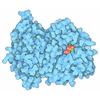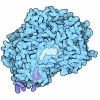[English] 日本語
 Yorodumi
Yorodumi- EMDB-72194: Cryo-EM Structure of the Class II Cyclase Domain in the Bifunctio... -
+ Open data
Open data
- Basic information
Basic information
| Entry |  | |||||||||
|---|---|---|---|---|---|---|---|---|---|---|
| Title | Cryo-EM Structure of the Class II Cyclase Domain in the Bifunctional Copalyl Diphosphate Synthase from Penicillium verruculosum | |||||||||
 Map data Map data | Unsharpened map Class II Cyclase Domain in the Bifunctional Copalyl Diphosphate Synthase from Penicillium verruculosum | |||||||||
 Sample Sample |
| |||||||||
 Keywords Keywords | Terpene / Natural products / Cyclization / LYASE | |||||||||
| Function / homology |  Function and homology information Function and homology informationcopalyl diphosphate synthase / alcohol biosynthetic process / mycotoxin biosynthetic process / geranylgeranyl diphosphate synthase / prenyltransferase activity / isoprenoid biosynthetic process / isomerase activity / metal ion binding Similarity search - Function | |||||||||
| Biological species |  Talaromyces verruculosus (fungus) Talaromyces verruculosus (fungus) | |||||||||
| Method | single particle reconstruction / cryo EM / Resolution: 2.9 Å | |||||||||
 Authors Authors | Gaynes MN / Christianson DW | |||||||||
| Funding support |  United States, 1 items United States, 1 items
| |||||||||
 Citation Citation |  Journal: bioRxiv / Year: 2025 Journal: bioRxiv / Year: 2025Title: Cryo-EM Structure of the Cyclase Domain and Evaluation of Substrate Channeling in a Bifunctional Class II Terpene Synthase. Authors: Matthew N Gaynes / Kollin Schultz / Eliott S Wenger / Trey A Ronnebaum / Ronen Marmorstein / David W Christianson Abstract: Copalyl diphosphate synthase from (PvCPS) is a bifunctional class II terpene synthase containing a prenyltransferase that produces geranylgeranyl diphosphate (GGPP) and a class II cyclase that ...Copalyl diphosphate synthase from (PvCPS) is a bifunctional class II terpene synthase containing a prenyltransferase that produces geranylgeranyl diphosphate (GGPP) and a class II cyclase that utilizes GGPP as a substrate to generate the bicyclic diterpene copalyl diphosphate. The various stereoisomers of copalyl diphosphate establish the greater family of labdane natural products, many of which have environmental and medicinal impact. Understanding structure-function relationships in class II diterpene synthases is crucial for guiding protein engineering campaigns aimed at the generation of diverse bicyclic diterpene scaffolds. However, only a limited number of structures are available for class II cyclases from bacteria, plants, and humans, and no structures are available for a class II cyclase from a fungus. Further, bifunctional class II terpene synthases have not been investigated with regard to substrate channeling between the prenyltransferase and the cyclase. Here, we report the 2.9 Å-resolution cryo-EM structure of the 63-kD class II cyclase domain from PvCPS. Comparisons with bacterial and plant copalyl diphosphate synthases reveal conserved residues that likely guide the formation of the bicyclic labdane core, but divergent catalytic dyads that mediate the final deprotonation step of catalysis. Substrate competition experiments reveal preferential GGPP transit from the PvCPS prenyltransferase to the cyclase, even when prepared as separate constructs. These results are consistent with a model in which transient prenyltransferase-cyclase association facilitates substrate channeling due to active site proximity. | |||||||||
| History |
|
- Structure visualization
Structure visualization
| Supplemental images |
|---|
- Downloads & links
Downloads & links
-EMDB archive
| Map data |  emd_72194.map.gz emd_72194.map.gz | 20.6 MB |  EMDB map data format EMDB map data format | |
|---|---|---|---|---|
| Header (meta data) |  emd-72194-v30.xml emd-72194-v30.xml emd-72194.xml emd-72194.xml | 19.8 KB 19.8 KB | Display Display |  EMDB header EMDB header |
| FSC (resolution estimation) |  emd_72194_fsc.xml emd_72194_fsc.xml | 6.4 KB | Display |  FSC data file FSC data file |
| Images |  emd_72194.png emd_72194.png | 54.9 KB | ||
| Filedesc metadata |  emd-72194.cif.gz emd-72194.cif.gz | 6.6 KB | ||
| Others |  emd_72194_additional_1.map.gz emd_72194_additional_1.map.gz emd_72194_half_map_1.map.gz emd_72194_half_map_1.map.gz emd_72194_half_map_2.map.gz emd_72194_half_map_2.map.gz | 19.9 MB 19.9 MB 19.9 MB | ||
| Archive directory |  http://ftp.pdbj.org/pub/emdb/structures/EMD-72194 http://ftp.pdbj.org/pub/emdb/structures/EMD-72194 ftp://ftp.pdbj.org/pub/emdb/structures/EMD-72194 ftp://ftp.pdbj.org/pub/emdb/structures/EMD-72194 | HTTPS FTP |
-Validation report
| Summary document |  emd_72194_validation.pdf.gz emd_72194_validation.pdf.gz | 768.4 KB | Display |  EMDB validaton report EMDB validaton report |
|---|---|---|---|---|
| Full document |  emd_72194_full_validation.pdf.gz emd_72194_full_validation.pdf.gz | 767.9 KB | Display | |
| Data in XML |  emd_72194_validation.xml.gz emd_72194_validation.xml.gz | 12.9 KB | Display | |
| Data in CIF |  emd_72194_validation.cif.gz emd_72194_validation.cif.gz | 16.9 KB | Display | |
| Arichive directory |  https://ftp.pdbj.org/pub/emdb/validation_reports/EMD-72194 https://ftp.pdbj.org/pub/emdb/validation_reports/EMD-72194 ftp://ftp.pdbj.org/pub/emdb/validation_reports/EMD-72194 ftp://ftp.pdbj.org/pub/emdb/validation_reports/EMD-72194 | HTTPS FTP |
-Related structure data
| Related structure data |  9q3iMC M: atomic model generated by this map C: citing same article ( |
|---|---|
| Similar structure data | Similarity search - Function & homology  F&H Search F&H Search |
- Links
Links
| EMDB pages |  EMDB (EBI/PDBe) / EMDB (EBI/PDBe) /  EMDataResource EMDataResource |
|---|---|
| Related items in Molecule of the Month |
- Map
Map
| File |  Download / File: emd_72194.map.gz / Format: CCP4 / Size: 22.2 MB / Type: IMAGE STORED AS FLOATING POINT NUMBER (4 BYTES) Download / File: emd_72194.map.gz / Format: CCP4 / Size: 22.2 MB / Type: IMAGE STORED AS FLOATING POINT NUMBER (4 BYTES) | ||||||||||||||||||||||||||||||||||||
|---|---|---|---|---|---|---|---|---|---|---|---|---|---|---|---|---|---|---|---|---|---|---|---|---|---|---|---|---|---|---|---|---|---|---|---|---|---|
| Annotation | Unsharpened map Class II Cyclase Domain in the Bifunctional Copalyl Diphosphate Synthase from Penicillium verruculosum | ||||||||||||||||||||||||||||||||||||
| Projections & slices | Image control
Images are generated by Spider. | ||||||||||||||||||||||||||||||||||||
| Voxel size | X=Y=Z: 1.07 Å | ||||||||||||||||||||||||||||||||||||
| Density |
| ||||||||||||||||||||||||||||||||||||
| Symmetry | Space group: 1 | ||||||||||||||||||||||||||||||||||||
| Details | EMDB XML:
|
-Supplemental data
-Additional map: Sharpened map
| File | emd_72194_additional_1.map | ||||||||||||
|---|---|---|---|---|---|---|---|---|---|---|---|---|---|
| Annotation | Sharpened map | ||||||||||||
| Projections & Slices |
| ||||||||||||
| Density Histograms |
-Half map: Half Map A
| File | emd_72194_half_map_1.map | ||||||||||||
|---|---|---|---|---|---|---|---|---|---|---|---|---|---|
| Annotation | Half Map A | ||||||||||||
| Projections & Slices |
| ||||||||||||
| Density Histograms |
-Half map: Half Map B
| File | emd_72194_half_map_2.map | ||||||||||||
|---|---|---|---|---|---|---|---|---|---|---|---|---|---|
| Annotation | Half Map B | ||||||||||||
| Projections & Slices |
| ||||||||||||
| Density Histograms |
- Sample components
Sample components
-Entire : Copalyl diphosphate synthase
| Entire | Name: Copalyl diphosphate synthase |
|---|---|
| Components |
|
-Supramolecule #1: Copalyl diphosphate synthase
| Supramolecule | Name: Copalyl diphosphate synthase / type: complex / ID: 1 / Parent: 0 / Macromolecule list: all |
|---|---|
| Source (natural) | Organism:  Talaromyces verruculosus (fungus) Talaromyces verruculosus (fungus) |
| Molecular weight | Theoretical: 108 KDa |
-Macromolecule #1: Copalyl diphosphate synthase
| Macromolecule | Name: Copalyl diphosphate synthase / type: protein_or_peptide / ID: 1 / Number of copies: 1 / Enantiomer: LEVO / EC number: copalyl diphosphate synthase |
|---|---|
| Source (natural) | Organism:  Talaromyces verruculosus (fungus) Talaromyces verruculosus (fungus) |
| Molecular weight | Theoretical: 110.996031 KDa |
| Recombinant expression | Organism:  |
| Sequence | String: MGSSHHHHHH SSGENLYFQG HMASMSPMDL QESAAALVRQ LGERVEDRRG FGFMSPAIYD TAWVSMISKT IDDQKTWLFA ECFQYILSH QLEDGGWAMY ASEIDAILNT SASLLSLKRH LSNPYQITSI TQEDLSARIN RAQNALQKLL NEWNVDSTLH V GFEILVPA ...String: MGSSHHHHHH SSGENLYFQG HMASMSPMDL QESAAALVRQ LGERVEDRRG FGFMSPAIYD TAWVSMISKT IDDQKTWLFA ECFQYILSH QLEDGGWAMY ASEIDAILNT SASLLSLKRH LSNPYQITSI TQEDLSARIN RAQNALQKLL NEWNVDSTLH V GFEILVPA LLRYLEDEGI AFAFSGRERL LEIEKQKLSK FKAQYLYLPI KVTALHSLEA FIGAIEFDKV SHHKVSGAFM AS PSSTAAY MMHATQWDDE CEDYLRHVIA HASGKGSGGV PSAFPSTIFE SVWPLSTLLK VGYDLNSAPF IEKIRSYLHD AYI AEKGIL GFTPFVGADA DDTATTILVL NLLNQPVSVD AMLKEFEEEH HFKTYSQERN PSFSANCNVL LALLYSQEPS LYSA QIEKA IRFLYKQFTD SEMDVRDKWN LSPYYSWMLM TQAITRLTTL QKTSKLSTLR DDSISKGLIS LLFRIASTVV KDQKP GGSW GTRASKEETA YAVLILTYAF YLDEVTESLR HDIKIAIENG CSFLSERTMQ SDSEWLWVEK VTYKSEVLSE AYILAA LKR AADLPDENAE AAPVINGIST NGFEHTDRIN GKLKVNGTNG TNGSHETNGI NGTHEIEQIN GVNGTNGHSD VPHDTNG WV EEPTAINETN GHYVNGTNHE TPLTNGISNG DSVSVHTDHS DSYYQRSDWT ADEEQILLGP FDYLESLPGK NMRSQLIQ S FNTWLKVPTE SLDVIIKVIS MLHTASLLID DIQDQSILRR GQPVAHSIFG TAQAMNSGNY VYFLALREVQ KLQNPKAIS IYVDSLIDLH RGQGMELFWR DSLMCPTEEQ YLDMVANKTG GLFCLAIQLM QAEATIQVDF IPLVRLLGII FQICDDYLNL KSTAYTDNK GLCEDLTEGK FSFPIIHSIR SNPGNRQLIN ILKQKPREDD IKRYALSYME STNSFEYTRG VVRKLKTEAI D TIQGLEKH GLEENIGIRK ILARMSLEL UniProtKB: Copalyl diphosphate synthase |
-Experimental details
-Structure determination
| Method | cryo EM |
|---|---|
 Processing Processing | single particle reconstruction |
| Aggregation state | particle |
- Sample preparation
Sample preparation
| Concentration | 1.0 mg/mL | ||||||||||||
|---|---|---|---|---|---|---|---|---|---|---|---|---|---|
| Buffer | pH: 7.5 Component:
| ||||||||||||
| Grid | Model: Quantifoil R1.2/1.3 / Material: COPPER / Mesh: 300 | ||||||||||||
| Vitrification | Cryogen name: ETHANE / Chamber humidity: 100 % / Chamber temperature: 277 K / Instrument: FEI VITROBOT MARK IV |
- Electron microscopy
Electron microscopy
| Microscope | TFS KRIOS |
|---|---|
| Image recording | Film or detector model: GATAN K3 BIOQUANTUM (6k x 4k) / Number grids imaged: 1 / Number real images: 4100 / Average exposure time: 3.29 sec. / Average electron dose: 33.0 e/Å2 |
| Electron beam | Acceleration voltage: 300 kV / Electron source:  FIELD EMISSION GUN FIELD EMISSION GUN |
| Electron optics | Illumination mode: FLOOD BEAM / Imaging mode: BRIGHT FIELD / Cs: 2.7 mm / Nominal defocus max: 2.5 µm / Nominal defocus min: 0.8 µm |
| Experimental equipment |  Model: Titan Krios / Image courtesy: FEI Company |
+ Image processing
Image processing
-Atomic model buiding 1
| Initial model | Chain - Source name: AlphaFold / Chain - Initial model type: in silico model |
|---|---|
| Output model |  PDB-9q3i: |
 Movie
Movie Controller
Controller





 Z (Sec.)
Z (Sec.) Y (Row.)
Y (Row.) X (Col.)
X (Col.)













































